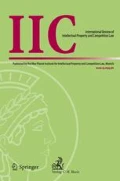-
1.
The patent law in India, as it stands today in the Patents Act, 1970, is fully TRIPS compliant. Nevertheless, it is to be judged and interpreted on its own terms, and not on the basis of standards of patentability prescribed in some countries of the Western world.
-
2.
The amendment/addition made in Sec. 3(d) of the Patents Act, 1970, is meant especially to deal with chemical substances, and more particularly pharmaceutical products, setting up a second tier of qualifying standards for such products in order to leave the door open for true and genuine inventions but also to check repetitive patenting or extension of the patent term on spurious grounds.
-
3.
Said Sec. 3(d) is an extension of the definition of “invention” and is linked to clauses (j) and (ja) of Sec. 2(1). Consequently, the Patents Act sets different standards for qualifying as “inventions” things belonging to different classes, and for medicines and drugs and other chemical substances, the Act sets the inventions threshold further higher.
-
4.
In the case at hand, the drug for which a patent is sought, fails to be a new product having come into being through an “invention” that has a feature that involves technical advance over the existing knowledge and that would make the invention not obvious to a person skilled in the art, as it is no more than a known substance from a previously existing patent and, thus, fails to qualify as an “invention”, as laid down in Sec. 2(1)(j) and (ja) of the Patents Act, 1970.
-
5.
The “coverage” of a patent does not go beyond the terms “disclosure”, “enablement” or “teaching”, as such would negate the fundamental rule underlying the grant of patents, which consists in the grant of a monopoly to a private individual in exchange for the invention being made public at the end of the patent term, so that all may benefit from it.
-
6.
The expression “known” in Sec. 3(d) does not connote proven and well-established nor does the expression “known efficacy” in the same Section imply efficacy established empirically and proven beyond doubt. It is sufficient that the product in question be known to the persons engaged in the pursuit of knowledge of the patented product or process either as men of science of men of commerce or consumers.
-
7.
In the case of a medicine that claims to cure a disease, the test of efficacy can only be “therapeutic efficacy”. Such must be judged strictly and narrowly. Furthermore, as the derivate must “differ significantly in properties with regard to efficacy”, not all advantageous or beneficial properties are relevant, but only such properties that directly relate to efficacy, which in case of medicine is its therapeutic efficacy.
-
8.
Properties inherent to form (e.g., solubility to a salt) are expressly excluded from the definition of “invention”, unless they differ significantly in property with regard to efficacy. In the case at hand, more beneficial flow properties, better thermodynamic stability and lower hygroscopicity, which may be otherwise beneficial, cannot be taken into account for the purpose of the test of Sec. 3(d) of the Act, since these properties have nothing to do with therapeutic efficacy.
-
9.
In the case of chemicals and especially pharmaceuticals, if the product for which patent protection is claimed as a new form of a known substance with known efficacy, then the subject product must pass, in addition to clauses (j) and (ja) of Sec. 2(1), the test of enhanced efficacy as provided in Sec. 3(d) read with its explanation.
Available at http://www.supremecourtofindia.nic.in/.
Author information
Consortia
Rights and permissions
About this article
Cite this article
Decision of the Supreme Court 1 April 2013 – Case Nos. 2706-2716 OF 2013; 2728 OF 2013; 2717-2727 OF 2013. “Glivec”. IIC 44, 843–844 (2013). https://doi.org/10.1007/s40319-013-0103-9
Published:
Issue Date:
DOI: https://doi.org/10.1007/s40319-013-0103-9

